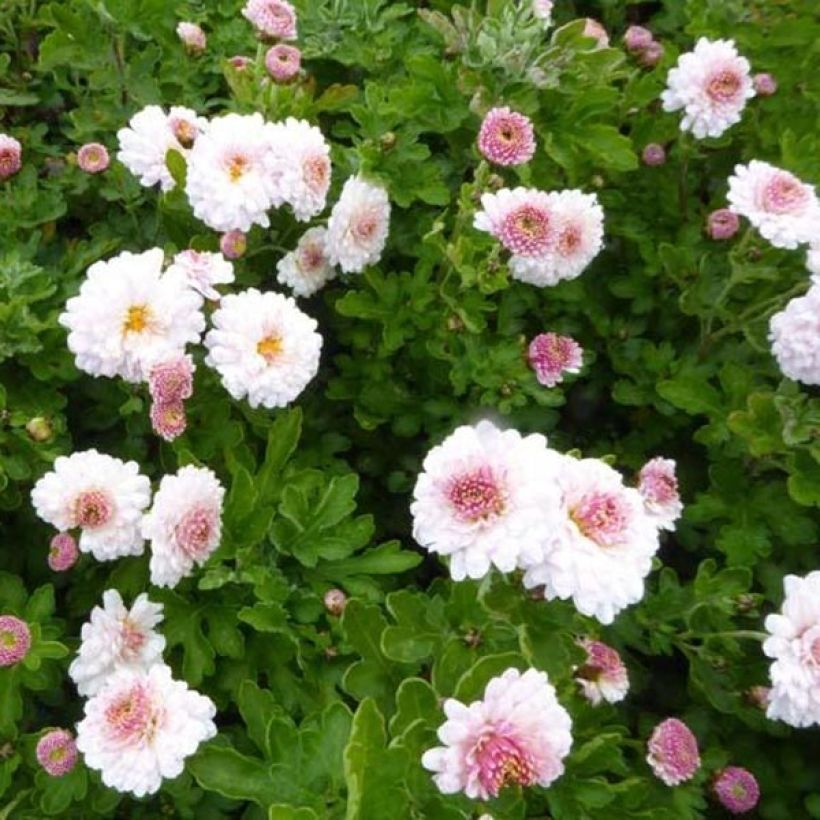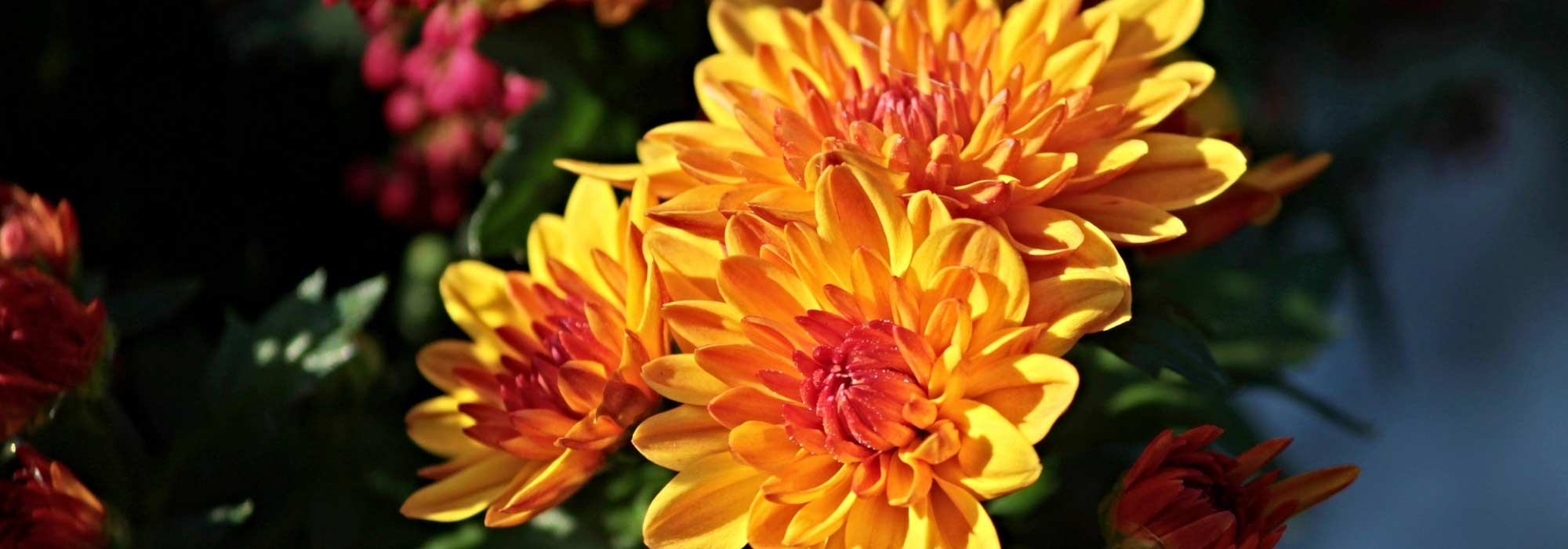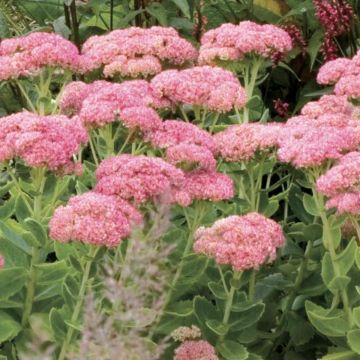

Chrysanthème des jardins Julia - Chrysanthemum (x) indicum
Chrysanthemum indicum Julia
Chrysanthemum indicum Julia
Garden Mum, Indian Chrysanthemum, Florist's Daisy
Hello, it's starting to grow now. Maybe some flowers this year?
Corinne , 28/07/2025
Special offer!
Receive a €20 voucher for any order over €90 (excluding delivery costs, credit notes, and plastic-free options)!
1- Add your favorite plants to your cart.
2- Once you have reached €90, confirm your order (you can even choose the delivery date!).
3- As soon as your order is shipped, you will receive an email containing your voucher code, valid for 3 months (90 days).
Your voucher is unique and can only be used once, for any order with a minimum value of €20, excluding delivery costs.
Can be combined with other current offers, non-divisible and non-refundable.
Home or relay delivery (depending on size and destination)
Schedule delivery date,
and select date in basket
This plant carries a 12 months recovery warranty
More information
We guarantee the quality of our plants for a full growing cycle, and will replace at our expense any plant that fails to recover under normal climatic and planting conditions.

Would this plant suit my garden?
Set up your Plantfit profile →
Description
Chrysanthemum x indicum 'Julia', better known as the Garden Chrysanthemum, is a true ode to autumn. It is a recent variety of garden chrysanthemum that offers original and charming flowering from September to November, in small pale pink pompoms with a darker heart, striped with light red and carmine, with shades reminiscent of salmon and cream yellow. This bushy perennial forms a regular and colourful dome, with numerous buds and exceptionally bright daisies. It is ideal in borders, combined with golden and purple foliage that will subtly enhance these pearly colours. It is a very hardy plant that only requires a normal, well-drained and moist soil, especially in summer, and a bright exposure without intense sunlight.
The 'Julia' Garden Chrysanthemum belongs to the Asteraceae family and is a cousin of daisies and sunflowers. It is a cultivar derived from Chrysanthemum indicum, a plant native to East Asia, cultivated since antiquity in China, Japan, and Korea, which is the origin of florist chrysanthemums.
This 'Julia' variety quickly forms a rounded clump consisting of woody-based, leafy, and branched stems, about 80 cm (32in) tall and 50 cm (20in) wide. The flowering lasts from September to November depending on the climate, and it spreads over several weeks. The plant is covered with numerous double pompom-shaped flowers, pale pink to rosy-white with a heart striped with light red/carmine, even taking on salmon and cream hues, which lighten as they bloom. The flowers are in fact heads of a few cm in diameter, grouped in clusters called corymbs at the ends of the branched stems. The leaves are borne on a petiole 1 to 2 cm (1in) long. The lamina is ovate to elliptical oval, measuring from 3 to 7 cm (1 to 3in) in length and 4 cm (2in) in width, pubescent, pinnate, more or less lobed, with a truncate base. The root system of this plant is a shallow rhizome. Its above-ground vegetation dries up in winter and regrows in spring.
Garden chrysanthemums offer immense worth during a time of year with somewhat fewer flowers, and blend remarkably well with autumn colours. They can be associated with asters in complementary colours. Their blooms can be lightened by e.g. cosmos, Japanese anemones, gauras, shrubby salvias, magellanica fuchsias, cafre lilies. They are particularly interesting when combined with grasses: Carex, Stipa, and Pennisetum. Chrysanthemums also make good cut flowers, very long-lasting in a vase. Consider using taller, brightly coloured varieties to create autumn borders at the base of deciduous bushes that reflect their yellow, red, and orange autumn foliage.
The aerial parts of Chrysanthemum indicum (flowers, leaves, and stems) are part of the Chinese pharmacopoeia. They are used in traditional medicine for the treatment of dizziness, symptoms of hypertension, and several infectious diseases.
Chrysanthemum indicum Julia in pictures




Flowering
Foliage
Plant habit
Botanical data
Chrysanthemum
indicum
Julia
Asteraceae
Garden Mum, Indian Chrysanthemum, Florist's Daisy
Cultivar or hybrid
Other Chrysanthemum
View all →Planting and care
Garden chrysanthemums require a sunny exposure, a light, slightly acidic to neutral, fertile soil, not too dry to moist. They are hardy down to at least -15°C (5°F). To maintain a compact habit, the stems can be pruned back in spring to 30 cm (12in), which will force the young plant to branch out. A second pinching in the summer allows for a greater number of small flowers. Water two or three times a week and apply a liquid fertiliser for flowering plants every eight days from July until the buds start to colour. Garden chrysanthemums are sturdy, very long-lived plants that can live for forty years or more. They have few enemies, but they dislike poorly drained and heavy soils, which lead to root rot. Slugs and snails love young shoots in spring; make sure to protect them!
Planting period
Intended location
Care
Planting & care advice
-
, onOrder confirmed
Reply from on Promesse de fleurs
Similar products
Haven't found what you were looking for?
Hardiness is the lowest winter temperature a plant can endure without suffering serious damage or even dying. However, hardiness is affected by location (a sheltered area, such as a patio), protection (winter cover) and soil type (hardiness is improved by well-drained soil).

Photo Sharing Terms & Conditions
In order to encourage gardeners to interact and share their experiences, Promesse de fleurs offers various media enabling content to be uploaded onto its Site - in particular via the ‘Photo sharing’ module.
The User agrees to refrain from:
- Posting any content that is illegal, prejudicial, insulting, racist, inciteful to hatred, revisionist, contrary to public decency, that infringes on privacy or on the privacy rights of third parties, in particular the publicity rights of persons and goods, intellectual property rights, or the right to privacy.
- Submitting content on behalf of a third party;
- Impersonate the identity of a third party and/or publish any personal information about a third party;
In general, the User undertakes to refrain from any unethical behaviour.
All Content (in particular text, comments, files, images, photos, videos, creative works, etc.), which may be subject to property or intellectual property rights, image or other private rights, shall remain the property of the User, subject to the limited rights granted by the terms of the licence granted by Promesse de fleurs as stated below. Users are at liberty to publish or not to publish such Content on the Site, notably via the ‘Photo Sharing’ facility, and accept that this Content shall be made public and freely accessible, notably on the Internet.
Users further acknowledge, undertake to have ,and guarantee that they hold all necessary rights and permissions to publish such material on the Site, in particular with regard to the legislation in force pertaining to any privacy, property, intellectual property, image, or contractual rights, or rights of any other nature. By publishing such Content on the Site, Users acknowledge accepting full liability as publishers of the Content within the meaning of the law, and grant Promesse de fleurs, free of charge, an inclusive, worldwide licence for the said Content for the entire duration of its publication, including all reproduction, representation, up/downloading, displaying, performing, transmission, and storage rights.
Users also grant permission for their name to be linked to the Content and accept that this link may not always be made available.
By engaging in posting material, Users consent to their Content becoming automatically accessible on the Internet, in particular on other sites and/or blogs and/or web pages of the Promesse de fleurs site, including in particular social pages and the Promesse de fleurs catalogue.
Users may secure the removal of entrusted content free of charge by issuing a simple request via our contact form.
The flowering period indicated on our website applies to countries and regions located in USDA zone 8 (France, the United Kingdom, Ireland, the Netherlands, etc.)
It will vary according to where you live:
- In zones 9 to 10 (Italy, Spain, Greece, etc.), flowering will occur about 2 to 4 weeks earlier.
- In zones 6 to 7 (Germany, Poland, Slovenia, and lower mountainous regions), flowering will be delayed by 2 to 3 weeks.
- In zone 5 (Central Europe, Scandinavia), blooming will be delayed by 3 to 5 weeks.
In temperate climates, pruning of spring-flowering shrubs (forsythia, spireas, etc.) should be done just after flowering.
Pruning of summer-flowering shrubs (Indian Lilac, Perovskia, etc.) can be done in winter or spring.
In cold regions as well as with frost-sensitive plants, avoid pruning too early when severe frosts may still occur.
The planting period indicated on our website applies to countries and regions located in USDA zone 8 (France, United Kingdom, Ireland, Netherlands).
It will vary according to where you live:
- In Mediterranean zones (Marseille, Madrid, Milan, etc.), autumn and winter are the best planting periods.
- In continental zones (Strasbourg, Munich, Vienna, etc.), delay planting by 2 to 3 weeks in spring and bring it forward by 2 to 4 weeks in autumn.
- In mountainous regions (the Alps, Pyrenees, Carpathians, etc.), it is best to plant in late spring (May-June) or late summer (August-September).
The harvesting period indicated on our website applies to countries and regions in USDA zone 8 (France, England, Ireland, the Netherlands).
In colder areas (Scandinavia, Poland, Austria...) fruit and vegetable harvests are likely to be delayed by 3-4 weeks.
In warmer areas (Italy, Spain, Greece, etc.), harvesting will probably take place earlier, depending on weather conditions.
The sowing periods indicated on our website apply to countries and regions within USDA Zone 8 (France, UK, Ireland, Netherlands).
In colder areas (Scandinavia, Poland, Austria...), delay any outdoor sowing by 3-4 weeks, or sow under glass.
In warmer climes (Italy, Spain, Greece, etc.), bring outdoor sowing forward by a few weeks.




























































